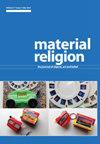Viva George: Celebrating Washington’s Birthday at the US-Mexico Border
IF 0.4
3区 哲学
0 RELIGION
引用次数: 0
Abstract
those who wished to retain their social privilege despite their newfound democratic principles. Awkward Rituals challenges readers to rethink their assumptions about rituals as sincere, productive, and cohesive. Rather than idealizing ritual as something that always fits the moment, Logan depicts ritual “as an unfashionable set of furniture that societies drag along with them, through revolutions and historical realignments” (9). This opens new questions for scholars of religion in any context about what happens when rituals and ideals do not cohere. Ritual may persist through changing times, but in doing so it can enact old ways of ordering the world, even when ritual actors themselves reject those old ways. Readers of Material Religion will be particularly interested in how Logan makes this argument through attention to sensation. She carefully mines her archival sources to describe what bodies were (or were supposed to be) doing or feeling in particular material contexts. She offers vivid sensory details: the regal fabrics used in masonic costumes, the tears streaming down the immobile face of an ABS subscriber, the mother selecting dinner condiments to regulate her family’s nervous system. At the same time, she resists the impulse to romanticize these sensations into coherence. The awkwardness of these rituals is a feature, not a bug. For those of us concerned with objects, bodies, spaces, and sensations, this book is an example of how we can generatively engage with the ambiguity and contradictions of the material world. At certain points in the book, the difficulties of knowing how historical subjects felt become apparent. Despite Logan’s extensive archives, there are limits to what we can learn about sensation from the archival record. I felt this acutely as I read discussions of benevolent reformers and sovereign mothers interacting with sailors and domestic servants, respectively. Did the sailors and servants experience these interactions as awkward in the same way a twenty first century reader might infer? Similarly, did masons feel awkward looking at the aprons covering their laps or the laps of the men sitting next to them (17)? These slippages occasionally obscured who was defining awkward and whose real or imagined sensations were evoked. Overall, a wide range of scholars will find Awkward Rituals provocative and generative. It would fit well in courses on ritual theory or theory and method in the study of religion, and the chapter on Catharine Beecher could easily stand alone in a women’s studies course. As a scholar of American religion, however, I am excited about how this book might intervene in how we study and teach religion in nineteenth century America. Logan’s work challenges lingering claims about Protestantism and democratization in this period, and it also offers a counterpoint to discussions of white evangelical aesthetics that emphasize enthusiastic melodrama over mundane bureaucracy. Most importantly, in my view, Logan helps us to see that what Tracy Fessenden has called “unmarked Protestantism” is more than a set of ideas: it is also a set of sensations. As so many of us wrestle with the embedded white Protestant norms in American society—including the civility and compliance demanded by white supremacy culture—this critical insight prompts us to pay attention to feeling as well as thought, and to inefficacy as well as production.乔治万岁:在美墨边境庆祝华盛顿的生日
这些人希望保留他们的社会特权,尽管他们有新的民主原则。尴尬的仪式挑战读者重新思考他们对仪式的假设是真诚的,富有成效的,有凝聚力的。洛根没有将仪式理想化,认为它总是适合当下,而是将仪式描述为“一套不时髦的家具,社会在革命和历史调整中拖着它一起走”(9)。这为宗教学者在任何背景下提出了新的问题,即当仪式和理想不一致时会发生什么。仪式可能会在不断变化的时代中持续存在,但在这样做的过程中,它可以制定旧的世界秩序方式,即使仪式的参与者自己也拒绝这些旧方式。《物质宗教》的读者会对洛根如何通过对感觉的关注来论证这一论点特别感兴趣。她仔细地挖掘她的档案来源,以描述身体在特定的物质背景下(或应该是)做什么或感觉。她提供了生动的感官细节:共济会服装中使用的皇家面料,ABS用户一动不动的脸上流下的眼泪,母亲选择晚餐调味品来调节家人的神经系统。与此同时,她抑制了把这些感觉浪漫化成连贯的冲动。这些仪式的尴尬是一种特性,而不是缺陷。对于我们这些关心物体、身体、空间和感觉的人来说,这本书是一个例子,告诉我们如何创造性地处理物质世界的模糊性和矛盾性。在书中的某些地方,了解历史主题感受的困难变得显而易见。尽管洛根有大量的档案,但我们能从档案记录中了解到的感觉是有限的。当我读到关于仁慈的改革者和君主母亲分别与水手和家仆互动的讨论时,我强烈地感受到这一点。水手和仆人们是否也像21世纪的读者可能推断的那样,经历了这些尴尬的互动?同样,泥瓦匠们看到围在他们腿上的围裙或坐在他们旁边的人的围裙会感到尴尬吗(17)?这些失误有时会模糊谁在定义尴尬,谁的真实或想象的感觉被唤起。总的来说,许多学者会发现尴尬的仪式具有挑衅性和生动性。它很适合仪式理论或宗教研究的理论与方法课程,凯瑟琳·比彻这一章很容易单独出现在女性研究课程中。然而,作为一名研究美国宗教的学者,我对这本书将如何介入我们如何研究和教授19世纪美国的宗教感到兴奋。洛根的作品挑战了这一时期关于新教和民主化的挥之不去的主张,它也为白人福音派美学的讨论提供了一个对比,白人福音派美学强调热情的情节剧而不是世俗的官僚主义。最重要的是,在我看来,洛根帮助我们看到Tracy Fessenden所说的“无标记的新教”不仅仅是一套思想:它也是一套感觉。当我们中的许多人与美国社会中根深蒂固的白人新教规范——包括白人至上文化所要求的文明和顺从——作斗争时,这种批判性的洞察力促使我们既关注思想,也关注感受,关注无效,也关注生产。
本文章由计算机程序翻译,如有差异,请以英文原文为准。
求助全文
约1分钟内获得全文
求助全文

 求助内容:
求助内容: 应助结果提醒方式:
应助结果提醒方式:


